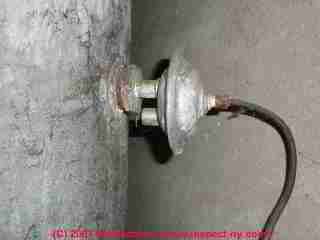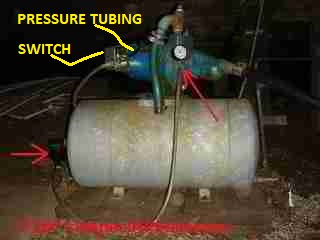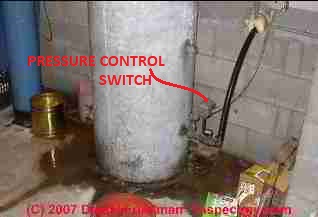 Air Volume Control (AVC) Test Procedures
Air Volume Control (AVC) Test Procedures
How to inspect & test the air volume control to determine if it is working
- POST a QUESTION or COMMENT about how to repair the air volume control (AVC) used on water pressure tanks & controls
Air volume control inspection & testing:
this article explains how inspect, test, & listen to the air volume control (AVC) on a water tank to determine whether or not the AVC is doing it's job.
InspectAPedia tolerates no conflicts of interest. We have no relationship with advertisers, products, or services discussed at this website.
- Daniel Friedman, Publisher/Editor/Author - See WHO ARE WE?
How to Test Air-Volume Controls (AVCs) on Water Tanks - is the AVC Working?
 How do we know if the AVC is working?
How do we know if the AVC is working?
Our photo (left, courtesy of reader Doug Mehak ) illustrates still another type of air volume control. The red arrow at the left of the photo points to the AVC and the right arrow points to the tubing connection on the water pump, in this case a one-line jet pump.
In our photos above and at left, most AVC controls that use a pressure sensing tube connected between the AVC and the water pump.
You will see a small diameter tube which connects the air volume control valve to a fitting (usually) on the water pump itself so that the valve can respond to the cycling on and off of the water pump (and changes in water pressure).
If the air volume control valve is working properly, it uses the pressure changes caused by the cycling on and off of the water pump to automatically add air to the water tank when it's needed. Makeup air is needed in these water tanks because over time the air charge in the tank is absorbed into the tank's water.
The most common versions of air volume controls, illustrated at the top of This article , look like a disk of about three inches in diameter, as we show in the photographs here. A copper or plastic tube that extends from the AVC to a fitting on the water pump itself, as we showed on the photograph above. Look at the fitting screwed into the side of the water tank about 2/3 of the way up from the tank bottom and on the right side of the water tank in the photograph above.
 If the air charge in your water pressure tank is not being maintained, either there is a leak in the tank or the AVC is not working. Usually the case is the latter.
If the air charge in your water pressure tank is not being maintained, either there is a leak in the tank or the AVC is not working. Usually the case is the latter.
Also illustrated earlier in this article, a second common version of air volume control valve is shaped like a small rectangular steel box with fittings shown in our two photographs above.
You also can see the small object connected to the side of the water tank near the top right side of the tank in this photograph at left.
There is no copper tube connected to this AVC. Here is a close-up photograph of this more rectangular type of air volume control.
If this AVC is working you will occasionally hear air hissing out of the fitting, as we discuss
at AIR VOLUME CONTROLS, HISSING.
...
Continue reading at AIR VOLUME CONTROL ADJUSTMENT or select a topic from the closely-related articles below, or see the complete ARTICLE INDEX.
Or see these
Recommended Articles
- AIR VOLUME CONTROL ADJUSTMENT
- AIR VOLUME CONTROLS, GET RID OF
- AIR VOLUME CONTROLS, HISSING
- AIR VOLUME CONTROL REPAIR repair procedures for Brady and other air volume control devices
- AIR VOLUME CONTROL TEST
- WATER TANK AIR VOLUME CONTROLS - home
- WATER TANK AIR, HOW TO ADD
- WATER TANK BLADDERS
Suggested citation for this web page
AIR VOLUME CONTROL TEST at InspectApedia.com - online encyclopedia of building & environmental inspection, testing, diagnosis, repair, & problem prevention advice.
Or see this
INDEX to RELATED ARTICLES: ARTICLE INDEX to WATER SUPPLY, PUMPS TANKS WELLS
Or use the SEARCH BOX found below to Ask a Question or Search InspectApedia
Ask a Question or Search InspectApedia
Try the search box just below, or if you prefer, post a question or comment in the Comments box below and we will respond promptly.
Search the InspectApedia website
Note: appearance of your Comment below may be delayed: if your comment contains an image, photograph, web link, or text that looks to the software as if it might be a web link, your posting will appear after it has been approved by a moderator. Apologies for the delay.
Only one image can be added per comment but you can post as many comments, and therefore images, as you like.
You will not receive a notification when a response to your question has been posted.
Please bookmark this page to make it easy for you to check back for our response.
IF above you see "Comment Form is loading comments..." then COMMENT BOX - countable.ca / bawkbox.com IS NOT WORKING.
In any case you are welcome to send an email directly to us at InspectApedia.com at editor@inspectApedia.com
We'll reply to you directly. Please help us help you by noting, in your email, the URL of the InspectApedia page where you wanted to comment.
Citations & References
In addition to any citations in the article above, a full list is available on request.
- [1] U.S. Gauge Special Application Gauges: Type 300L and 310WJ Air Volume Controls, product description, 2002, Ametek® Inc, U.S. Gauge, 820 Pennsylvania Blvd., Feasterville PA 19053, USA, Tel: 215-355-6900 www.ametekusg.com Customer Service: 863-534-1504, web search 03/23/2011, original source: http://www.jlwinstruments.com/PDF_files/D17_MODEL300-310.PDF Sadly this URL now reroutes to a dead end
- [2] AMTEK, 900 Clymer Avenue 8600 Somerset Drive Sellersville, PA 18960 U.S.A. or Customer Service at AMTEK, Largo, FL 33773 U.S.A.Sales/Technical Support: 215-257-6531, Customer Service: 727-536-7831, Website: www.amtekusg.com, Email US Gauge at usg.sales@ametek.com.
- [3] flosource.com/ provides links to some US Gauge air volume control products installation and adjustment
- Rasmussen Well Drilling, Inc., 1793 Hwy 61, Two Harbors MN. Jeremy Rasmussen provides third generation well drilling and plumbing services on the North Shore of Lake Superior. Photos by DJF. Tel 218-834-3387. Email: rasmussenwell@frontier.com
Quoting: We serve the north Shore – Lake, Cook, St. Louis, Carlton and Pine counties, including Duluth, Grand Marais, Clouqet, Carlton, Finland, Isabella, Silver Bay, Grand Portage, Saginaw, and everywhere in Northeastern Minnesota. - [5] Dill Air Controls Products, 1500 Williamsboro St., PO Box 159, Oxford, NC 27565, Tel: (919) 692‐2300, Website: http://dillaircontrols.com
- Smart Tank, Installation Instructions, Flexcon Industries, 300 Pond St., Randolph MA 02368, www.flexconind.com, Tel: 800-527-0030 - web search 07/24/2010, original source: http://www.flexconind.com/pdf/st_install.pdf [Copy on file as /water/Smart_Tank_Flexcon.pdf ] -
- Typical Shallow Well One Line Jet Pump Installation, Grove Electric, G&G Electric & Plumbing, 1900 NE 78th St., Suite 101, Vancouver WA 98665 www.grovelectric.com - web search -7/15/2010 original source: http://www.groverelectric.com/howto/38_Typical%20Jet%20Pump%20Installation.pdf, [Copy on file as /water/Jet_Pump_Grove_Elect_Jet_Pumps.pdf ] -
- Typical Deep Well Two Line Jet Pump Installation, Grove Electric, G&G Electric & Plumbing, 1900 NE 78th St., Suite 101, Vancouver WA 98665 www.grovelectric.com - web search -7/15/2010 original source: http://www.groverelectric.com/howto/38_Typical%20Jet%20Pump%20Installation.pdf, [Copy on file as /water/Jet_Pump_Grove_Elect.pdf ] - Cooperative Extension, School of Forest Resources, web search 07/24/2010, original source: http://pubs.cas.psu.edu/FreePubs/pdfs/XH0002.pdf
- Our recommended books about building & mechanical systems design, inspection, problem diagnosis, and repair, and about indoor environment and IAQ testing, diagnosis, and cleanup are at the InspectAPedia Bookstore. Also see our Book Reviews - InspectAPedia.
- In addition to citations & references found in this article, see the research citations given at the end of the related articles found at our suggested
CONTINUE READING or RECOMMENDED ARTICLES.
- Carson, Dunlop & Associates Ltd., 120 Carlton Street Suite 407, Toronto ON M5A 4K2. Tel: (416) 964-9415 1-800-268-7070 Email: info@carsondunlop.com. Alan Carson is a past president of ASHI, the American Society of Home Inspectors.
Thanks to Alan Carson and Bob Dunlop, for permission for InspectAPedia to use text excerpts from The HOME REFERENCE BOOK - the Encyclopedia of Homes and to use illustrations from The ILLUSTRATED HOME .
Carson Dunlop Associates provides extensive home inspection education and report writing material. In gratitude we provide links to tsome Carson Dunlop Associates products and services.

